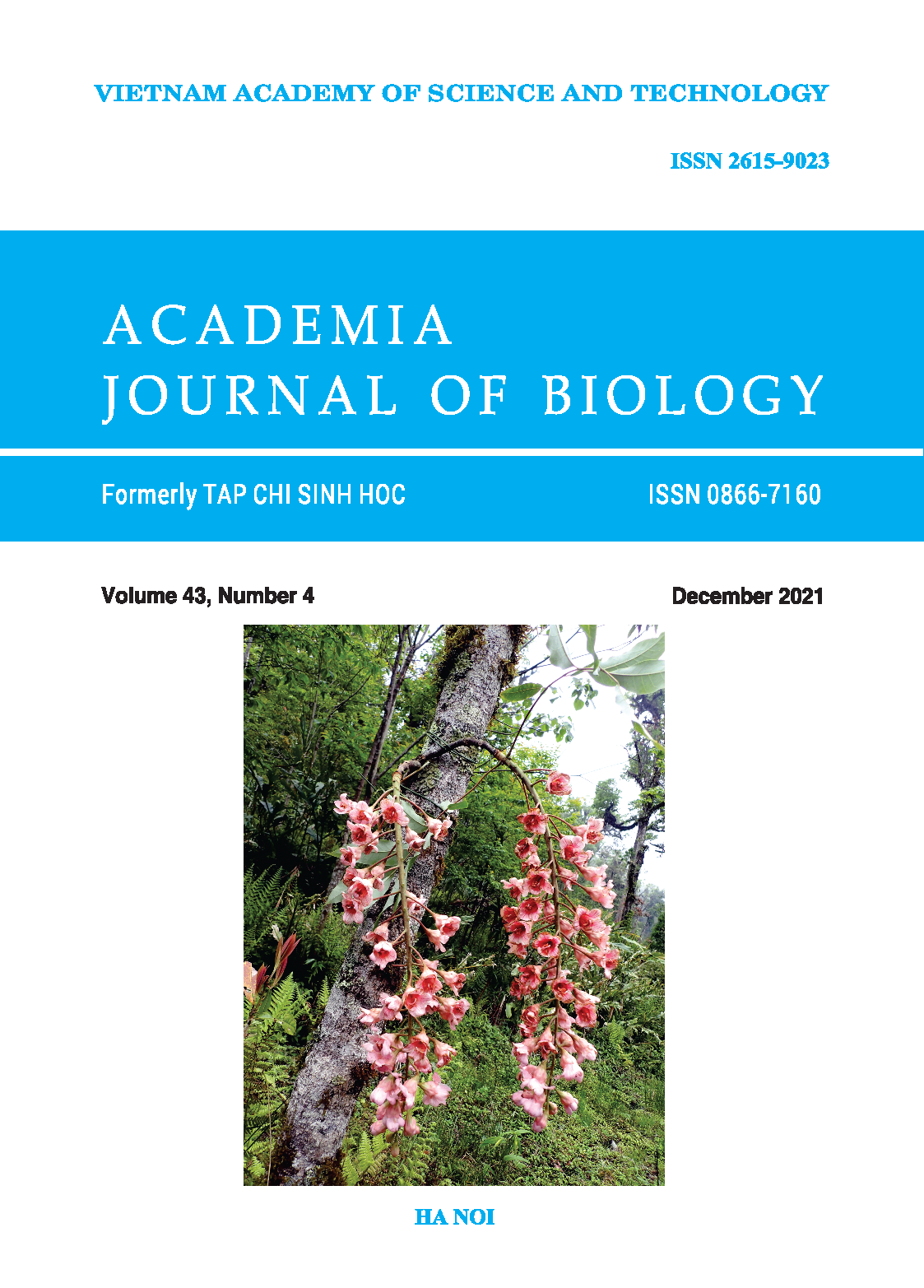Isolation and characterization of a gene encoding farnesyl diphosphate synthase from Panax vietnamensis Ha et Grushv
Author affiliations
DOI:
https://doi.org/10.15625/2615-9023/16356Keywords:
Panax vietnamensis, ginsenoside biosynthesis, triterpenoid saponins, farnesyl diphosphate synthase, farnesyl pyrophosphate synthase, gene expressionAbstract
Panax vietnamensis Ha et Grushv. is a species of the genus Panax native to Central Vietnam, containing a family of triterpene saponins named ginsenosides. This group of biomolecules possesses valuable therapeutic properties against cancer, hepatitis, diabetes, inflammation as well as stress and anxiety. Farnesyl diphosphate synthase (FPS) is a key enzyme participating in the ginsenoside biosynthesis pathway. In this study, a FPS gene from P. vietnamensis (PvFPS) was isolated and characterized. The PvFPS cDNA contained an open reading frame of 1032 bp, encoding a polypeptide chain of 342 amino acid residues. Nucleotide sequence comparison showed that FPS was highly conserved among most species, with two Aspartate-rich motifs responsible for product chain length determination strongly sustained. PvFPS was closely related to those of the same genera and order and differed from those from other kingdoms. PvFPS expression was detected at a greater level in root tissues than in leaves in all ages. Our findings provided information concerning the properties of a crucial gene in the ginsenoside biosynthesis, thus enhancing our understanding of this important pathway.
Downloads
References
Banskota A., Tezuka Y., Tran Q., Kadota S., 2005. Chemical constituents and biological activities of Vietnamese medicinal plants. Curr. Top. Med. Chem., 3(2): 227–248. https://doi.org/10.2174/ 1568026033392516
Cao X., Yin T., Miao Q., Li C., Ju X., Sun Y., Jiang J., 2012. Molecular characterization and expression analysis of a gene encoding for farnesyl diphosphate synthase from Euphorbia pekinensis Rupr. Mol. Biol. Rep., 39(2): 1487–1492. https://doi.org/10.1007/s11033-011-0886-z
Cunillera N., Arró M., Delourme D., Karst F., Boronat A., Ferrer A., 1996. Arabidopsis thaliana contains two differentially expressed farnesyl-diphosphate synthase genes. J. Biol. Chem., 271(13): 7774–7780. https://doi.org/10.1074/ jbc.271.13.7774
Dixon H. B. F., Bielka H., Cantor C. R., 1986. Nomenclature committee for the International Union of Biochemistry (NC-IUB). Nomenclature for incompletely specified bases in nucleic acid sequences. Recommendations 1984. Proc. Natl. Acad. Sci. U. S. A., 83(1): 4–8. https://doi.org/10.1073/pnas.83.1.4
Do H. Q., Truong N. H., Lam T. T., Nguyen L. T., Le D. M., Dinh N. H. T., Tran L. C., Le P. T. B., Phan N. K., Pham P. Van, 2019. The effects of the Panax vietnamensis ethanol fraction on proliferation and differentiation of mouse neural stem cells. Biomed. Res. Ther., 6(10): 3422–3432. https://doi.org/ 10.15419/bmrat.v6i10.571
Gupta P., Akhtar N., Tewari S. K., Sangwan R. S., Trivedi P. K., 2011. Differential expression of farnesyl diphosphate synthase gene from Withania somnifera in different chemotypes and in response to elicitors. Plant Growth Regul., 65(1):
–100. https://doi.org/10.1007/s10725-011-9578-x
Hemmerlin A., Rivera S. B., Erickson H. K., Poulter C. D., 2003. Enzymes encoded by the farnesyl diphosphate synthase gene family in the Big Sagebrush Artemisia tridentata ssp. spiciformis. J. Biol. Chem., 278(34): 32132–32140. https://doi.org/ 10.1074/jbc.M213045200
Jeong J. J., Van Le T. H., Lee S. Y., Eun S. H., Nguyen M. D., Park J. H., Kim D. H., 2015. Anti-inflammatory effects of vina-ginsenoside R2 and majonoside R2 isolated from Panax vietnamensis and their metabolites in lipopolysaccharide-stimulated macrophages. Int. Immunopharmacol., 28(1): 700–706. https://doi.org/10.1016/j.intimp.2015.07.025
Kim O. T., Ahn J. C., Hwang S. J., Hwang B., 2005. Cloning and expression of a farnesyl diphosphate synthase in Centella asiatica (L.) Urban. Mol. Cells., 19(2): 294–299.
Kim O. T., Bang K. H., Jung S. J., Kim Y. C., Hyun D. Y., Kim S. H., Cha S. W., 2010. Molecular characterization of ginseng farnesyl diphosphate synthase gene and its up-regulation by methyl jasmonate. Biol. Plant., 54(1): 47–53. https://doi.org/ 10.1007/s10535-010-0007-1
Koyama T., Obata S., Osabe M., Saito K., Takeshita A., Nishino T., Ogura K., 1994. Thermostable farnesyl diphosphate synthase of Bacillus stearothermophilus: crystallization and site-directed mutagenesis. Acta Biochim. Pol., 41(3): 281–292.
Schmidt A., Gershenzon J., 2007. Cloning and characterization of isoprenyl diphosphate synthases with farnesyl diphosphate and geranylgeranyl diphosphate synthase activity from Norway spruce (Picea abies) and their relation to induced oleoresin formation. Phytochemistry., 68(21): 2649–2659. https://doi.org/10.1016/ j.phytochem.2007.05.037
Shin B. K., Kwon S. W., Park J. H., 2015. Chemical diversity of ginseng saponins from Panax ginseng. J. Ginseng Res., 39(4): 287–298. https://doi.org/10.1016/ J.JGR.2014.12.005
Szkopińska A., Płochocka D., 2005. Farnesyl diphosphate synthase; regulation of product specificity. Acta Biochim. Pol., 52(1): 45–55.
Vu-Huynh K. L., Le T. H. V., Nguyen H. T., Kim H. M., Kang K. S., Park J. H., Nguyen M. D., 2019. Increase in protective effect of Panax vietnamensis by heat processing on cisplatin-induced kidney cell toxicity. Molecules., 24(24): 4627. https://doi.org/10.3390/ molecules24244627
Wang P., Liao Z., Guo L., Li W., Chen Mi., Pi Y., Gong Y., Sun X., Tang K., 2004. Cloning and functional analysis of a cDNA encoding Ginkgo biloba farnesyl diphosphate synthase. Mol. Cells., 18(2): 150–156.
Xia P., Zheng Y., Liang Z., 2019. Structure and location studies on key enzymes in saponins biosynthesis of Panax notoginseng. Int. J. Mol. Sci., 20(24): 6121. https://doi.org/10.3390/ ijms20246121
Zhang G. H., Ma C. H., Zhang J. J., Chen J. W., Tang Q. Y., He M. H., Xu X. Z., Jiang N. H., Yang S. C., 2015. Transcriptome analysis of Panax vietnamensis var. fuscidicus discovers putative ocotillol-type ginsenosides biosynthesis genes and genetic markers. BMC Genomics, 16(1): 159. https://doi.org/10.1186/s12864-015-1332-8
Downloads
Published
How to Cite
Issue
Section
License
Academia Journal of Biology (AJB) is an open-access and peer-reviewed journal. The articles published in the AJB are licensed under a Creative Commons Attribution-NonCommercial-NoDerivatives 4.0 International License (CC BY-NC-ND 4.0), which permits for immediate free access to the articles to read, download, copy, non-commercial use, distribution and reproduction in any medium, provided the work is properly cited (with a link to the formal publication through the relevant DOI), and without subscription charges or registration barriers. The full details of the CC BY-NC-ND 4.0 License are available at https://creativecommons.org/licenses/by-nc-nd/4.0/.












